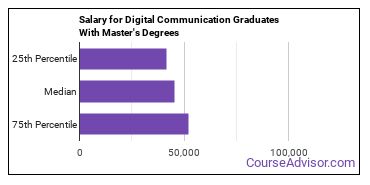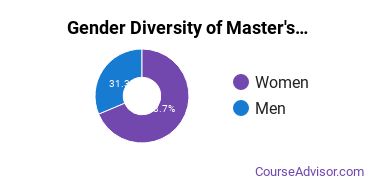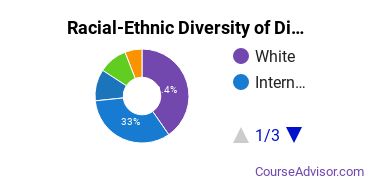Master’s Degrees in Radio, Television & Digital Communication
Featured schools near , edit
Education Levels of Digital Communication Majors
During the 2020-2021 academic year, 2,343 students earned their master's degree in digital communication. This earns it the #65 spot on the list of the most popular master's degree programs in the nation.
The following table shows the number of diplomas awarded in digital communication at each degree level.
| Education Level | Number of Grads |
|---|---|
| Bachelor’s Degree | 11,580 |
| Master’s Degree | 2,343 |
| Associate Degree | 1,367 |
| Basic Certificate | 1,135 |
| Undergraduate Certificate | 1,025 |
| Graduate Certificate | 156 |
| Doctor’s Degree | 63 |
Earnings of Digital Communication Majors With Master’s Degrees
The median salary for graduates holding a master's degree in digital communication is $45,590. A lot of factors can contribute to this number, such as the location of your workplace and the availability of other perks and bonuses. To get a better picture, earnings for this category of people can range from a low of $41,795 to a high of $51,957.

Student Debt
The data on debt ranges for digital communication majors who have their master's degree is not available.
Student Diversity
More women than men pursue their master's degree in digital communication. About 68.7% of graduates with this degree are female.
| Gender | Number of Grads |
|---|---|
| Men | 734 |
| Women | 1,609 |

The racial-ethnic distribution of digital communication master’s degree students is as follows:
| Race/Ethnicity | Number of Grads |
|---|---|
| Asian | 118 |
| Black or African American | 241 |
| Hispanic or Latino | 221 |
| White | 898 |
| International Students | 734 |
| Other Races/Ethnicities | 131 |

Most Popular Digital Communication Programs for Master’s Degrees
There are 94 colleges that offer a master’s degree in digital communication. Learn more about the most popular 20 below:
Northwestern University tops the list of the most popular school in the U.S. for digital communication majors who are seeking their master's degree. Each year, around 22,600 students seeking various degrees attend the university. The average in-state tuition for full-time undergraduates is $60,276 per year, while in-state graduate students, on average, pay $56,067 per year. During the 2020-2021 academic year, 284 people received their master's degree in digital communication from Northwestern. Of these students, 77% were women and 25% were members of underrepresented racial-ethnic groups.
Arizona State University - Skysong comes in at #2 on our list of the most popular colleges offering master's degrees in digital communication. Roughly 53,900 attend the school each year. The average in-state tuition for full-time undergraduates is $10,710 per year, while in-state graduate students, on average, pay $9,774 per year. During the 2020-2021 academic year, 189 people received their master's degree in digital communication from ASU - Skysong. Around 36% of these students were from an underrepresented racial-ethnic group, and 70% were women.
New York University is the 3rd most popular school in the nation for students seeking a master's degree in digital communication. Roughly 52,700 attend the school each year. The average in-state tuition for full-time undergraduates is $53,770 per year, while in-state graduate students, on average, pay $35,982 per year. The digital communication program at New York University awarded 158 master's degrees during the 2020-2021 school year. Around 24% of these students were from an underrepresented racial-ethnic group, and 72% were women.
The 4th most popular school in the country for digital communication majors who are seeking their master's degree is The New School. Each year, around 9,000 students seeking various degrees attend the university. The average in-state tuition for full-time undergraduates is $51,122 per year, while in-state graduate students, on average, pay $47,920 per year. The digital communication program at The New School awarded 151 master's degrees during the 2020-2021 school year. Around 34% of these students were from an underrepresented racial-ethnic group, and 75% were women.
Liberty University comes in at #5 on our list of the most popular colleges offering master's degrees in digital communication. Roughly 93,300 attend the school each year. The average in-state tuition for full-time undergraduates is $15,409 per year, while in-state graduate students, on average, pay $7,847 per year. For the 2020-2021 academic year, 109 master's degrees were handed out to digital communication majors at Liberty University. Around 31% of these students were from an underrepresented racial-ethnic group, and 64% were women.
The Graduate Center, CUNY comes in at #6 on our list of the most popular colleges offering master's degrees in digital communication. Each year, around 9,300 students seeking various degrees attend the university. The average in-state tuition for full-time undergraduates is $6,930 per year, while in-state graduate students, on average, pay $9,930 per year. During the 2020-2021 academic year, 96 people received their master's degree in digital communication from The Graduate Center. About 65% of this group were women, and 40% were students from an underrepresented racial-ethnic group.
Fordham University is the 6th most popular school in the nation for students seeking a master's degree in digital communication. Roughly 16,300 attend the school each year. The average in-state tuition for full-time undergraduates is $54,730 per year, while in-state graduate students, on average, pay $23,112 per year. The digital communication program at Fordham University awarded 96 master's degrees during the 2020-2021 school year. Of these students, 71% were women and 39% were members of underrepresented racial-ethnic groups.
The 8th most popular school in the country for digital communication majors who are seeking their master's degree is University of Washington - Seattle Campus. Each year, around 48,100 students seeking various degrees attend the university. The average in-state tuition for full-time undergraduates is $10,927 per year, while in-state graduate students, on average, pay $16,605 per year. During the 2020-2021 academic year, 94 people received their master's degree in digital communication from UW Seattle. Of these students, 69% were women and 31% were members of underrepresented racial-ethnic groups.
Savannah College of Art and Design comes in at #9 on our list of the most popular colleges offering master's degrees in digital communication. Each year, around 14,200 students seeking various degrees attend the university. The average in-state tuition for full-time undergraduates is $38,340 per year, while in-state graduate students, on average, pay $39,240 per year. The digital communication program at Savannah College of Art and Design awarded 77 master's degrees during the 2020-2021 school year. About 75% of this group were women, and 13% were students from an underrepresented racial-ethnic group.
The 10th most popular school in the country for digital communication majors who are seeking their master's degree is Michigan State University. Roughly 49,600 attend the school each year. The average in-state tuition for full-time undergraduates is $15,966 per year, while in-state graduate students, on average, pay $19,714 per year. During the 2020-2021 academic year, 68 people received their master's degree in digital communication from Michigan State. Around 13% of these students were from an underrepresented racial-ethnic group, and 72% were women.
The 11th most popular school in the country for digital communication majors who are seeking their master's degree is Boston University. Each year, around 32,700 students seeking various degrees attend the university. The average in-state tuition for full-time undergraduates is $58,560 per year, while in-state graduate students, on average, pay $58,560 per year. During the 2020-2021 academic year, 65 people received their master's degree in digital communication from Boston U. Of these students, 75% were women and 14% were members of underrepresented racial-ethnic groups.
Northeastern University Professional Advancement Network is the 12th most popular school in the nation for students seeking a master's degree in digital communication. Each year, around 11,300 students seeking various degrees attend the university. The average in-state tuition for full-time undergraduates is $12,984 per year, while in-state graduate students, on average, pay $22,866 per year. The digital communication program at Northeastern University Professional Advancement Network awarded 62 master's degrees during the 2020-2021 school year. Of these students, 61% were women and 11% were members of underrepresented racial-ethnic groups.
Rochester Institute of Technology is the 13th most popular school in the nation for students seeking a master's degree in digital communication. Each year, around 16,100 students seeking various degrees attend the university. The average in-state tuition for full-time undergraduates is $50,225 per year, while in-state graduate students, on average, pay $52,092 per year. For the 2020-2021 academic year, 49 master's degrees were handed out to digital communication majors at RIT. Of these students, 82% were women and 8% were members of underrepresented racial-ethnic groups.
The 14th most popular school in the country for digital communication majors who are seeking their master's degree is University of Southern California. Roughly 46,200 attend the school each year. The average in-state tuition for full-time undergraduates is $60,446 per year, while in-state graduate students, on average, pay $60,446 per year. During the 2020-2021 academic year, 48 people received their master's degree in digital communication from USC. Of these students, 77% were women and 23% were members of underrepresented racial-ethnic groups.
Massachusetts Institute of Technology comes in at #15 on our list of the most popular colleges offering master's degrees in digital communication. Each year, around 11,200 students seeking various degrees attend the university. The average in-state tuition for full-time undergraduates is $55,510 per year, while in-state graduate students, on average, pay $55,510 per year. For the 2020-2021 academic year, 40 master's degrees were handed out to digital communication majors at MIT. Of these students, 40% were women and 18% were members of underrepresented racial-ethnic groups.
University of California - Berkeley is the 15th most popular school in the nation for students seeking a master's degree in digital communication. Each year, around 42,300 students seeking various degrees attend the university. The average in-state tuition for full-time undergraduates is $11,442 per year, while in-state graduate students, on average, pay $11,442 per year. The digital communication program at University of California - Berkeley awarded 40 master's degrees during the 2020-2021 school year. Of these students, 70% were women and 40% were members of underrepresented racial-ethnic groups.
Temple University comes in at #17 on our list of the most popular colleges offering master's degrees in digital communication. Roughly 37,200 attend the school each year. The average in-state tuition for full-time undergraduates is $16,488 per year, while in-state graduate students, on average, pay $17,388 per year. For the 2020-2021 academic year, 39 master's degrees were handed out to digital communication majors at Temple. About 69% of this group were women, and 33% were students from an underrepresented racial-ethnic group.
Universidad del Sagrado Corazon comes in at #18 on our list of the most popular colleges offering master's degrees in digital communication. Each year, around 4,500 students seeking various degrees attend the university. The average in-state tuition for full-time undergraduates is $4,920 per year, while in-state graduate students, on average, pay $4,230 per year. For the 2020-2021 academic year, 38 master's degrees were handed out to digital communication majors at Sagrado. Around 100% of these students were from an underrepresented racial-ethnic group, and 63% were women.
Syracuse University is the 19th most popular school in the nation for students seeking a master's degree in digital communication. Roughly 21,300 attend the school each year. The average in-state tuition for full-time undergraduates is $55,920 per year, while in-state graduate students, on average, pay $41,616 per year. The digital communication program at Syracuse University awarded 31 master's degrees during the 2020-2021 school year. About 58% of this group were women, and 26% were students from an underrepresented racial-ethnic group.
The 20th most popular school in the country for digital communication majors who are seeking their master's degree is Thomas Jefferson University. Roughly 8,200 attend the school each year. The average in-state tuition for full-time undergraduates is $41,900 per year, while in-state graduate students, on average, pay $22,068 per year. During the 2020-2021 academic year, 29 people received their master's degree in digital communication from Thomas Jefferson University. About 69% of this group were women, and 21% were students from an underrepresented racial-ethnic group.
Explore Major by State
Alabama
Arkansas
Connecticut
Florida
Idaho
Iowa
Louisiana
Massachusetts
Mississippi
Nebraska
New Jersey
North Carolina
Oklahoma
Rhode Island
Tennessee
Vermont
West Virginia
Related Majors
Below are some popular majors that are similar to digital communication that offer master’s degrees.
| Major | Annual Degrees Awarded |
|---|---|
| Communication & Media Studies | 4,407 |
| Public Relations & Advertising | 2,542 |
| Journalism | 1,181 |
| Other Communication & Journalism | 314 |
| Publishing | 210 |
References
*The racial-ethnic minority student count is calculated by taking the total number of students and subtracting white students, international students, and students whose race/ethnicity was unknown. This number is then divided by the total number of students at the school to obtain the percentage of racial-ethnic minorities.
- College Factual
- National Center for Education Statistics
- O*NET Online
- Bureau of Labor Statistics
- Image Credit: By {} under License
More about our data sources and methodologies.
Featured Schools
 Request Info
Request Info
|
Southern New Hampshire University You have goals. Southern New Hampshire University can help you get there. Whether you need a bachelor's degree to get into a career or want a master's degree to move up in your current career, SNHU has an online program for you. Find your degree from over 200 online programs. Learn More > |




















